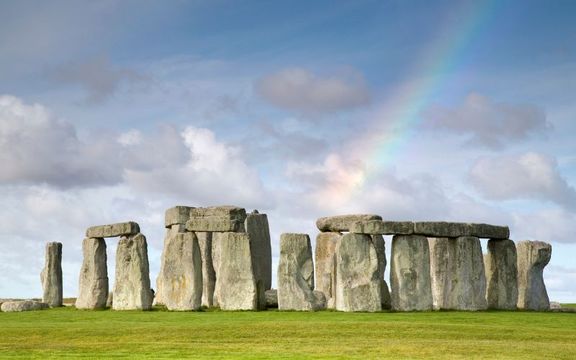
Stonehenge & Spring Equinox Getty
Every March, pagans and druids gather before dawn at Stonehenge to celebrate the Spring Equinox and see the sun rise above the famous stone circle.
Although more famous for the role it plays with the winter and summer solstice, the equinox at Stonehenge can be just as magical for those who continue to visit every spring. This year, the equinox takes place on 21st March and for those lucky enough to be within the circle itself it promises to be a once-in-a-lifetime event. While thousands will gather outside the inner circle, only those with a pre-bought ticket will get to witness the sunrise from within the circle and will gain access before the crowds arrive.
The purpose of the stone circle, which has been in existence since 2500 AD, remains a mystery for scholars and locals alike. It’s not strictly a burial ground (although some remains have been found) or a monument and seems to serve no purpose except to welcome the changing seasons. The stones are positioned in a sarsen horseshoe shape with the rising sun appearing between two of the largest stones placed on each side of the structure - depending on whether it’s midsummer or midwinter, forming an almost medieval calendar.
Those who built Stonehenge would have comprised farmers, herders and pastoralists so tracking the seasons would have been as important as it was practical - changing seasons impacts what can be planted and, more importantly, what grows. It is believed that the midwinter solstice was the most important to those who worshipped at Stonehenge, as the stones through which the sun rises in December are straight ahead of visitors as they walk to the monument - much like an altar is in a church. This theory is further cemented by the fact that the residents of Durrington Walls, a settlement found to the northwest of Stonehenge, gathered to feast at Stonehenge as pig bones were found among pits and rubbish dumps discovered there. Experts could show that these pigs were killed at roughly nine years old, meaning if they were born in spring as piglets traditionally are, they then were eaten at midwinter. Furthermore, cattle bones found at the same site were not local to Somerset which shows that midwinter was a time when families and communities reunited over great distances to feast and worship.
And what of the circle now? While some of the stones have fallen into disarray, the structure itself is visible and by excavating foundations, archaeologists have been able to estimate what the circle looked like in its entirety. For example the famous Heel Stone, which stands alone next to the structure, was found to have potentially had a mate, after the foundations were discovered nearby for a similar size stone. Of the remaining six lindels, experts can see how and where they were secured to their neighbours, while the remaining stones have also been finished to give the illusion of an unbroken circle - some 30m in diameter. While Stone 52 is subtly marked with the word Wren which experts believe means that it was engraved by Sir Christopher Wren, who lived with his family nearby and is perhaps best known for being the architect behind St Paul’s Cathedral.
Read more
Public access to the circle was freely permitted until the 1970s when experts realised that constant footfall was damaging not only the stones but also the ground beneath them. While only half of the site has been excavated, carvings which were carried out at the time of construction are visible to the naked eye - a unique attribute to Stonehenge and something that is not replicated on stone circles around the world.
One of the most famous prehistoric sites in the world, Stonehenge is currently in the hands of English Heritage, which considers it to be part of a 'sacred landscape' which includes other historical and ancient sites. The support of a governing body has seen Stonehenge receive funding to improve its Visitor Centre and create a tunnel so that the nearby A303 no longer obscures or impacts the experience - meaning even those who have visited the site before can learn something new from a return visit. Other examples of sacred landscapes currently looked after by English Heritage include Avebury Stone Circle, including Windmill Hill; The Sanctuary, West Kennet Avenue with its burial mound West Kennet Long Barrow, and of course the famous, enduring mystery of Silbury Hill. By working together and examining all prehistoric structures, today’s population are able to gain insite into how our ancestors lived.





Comments